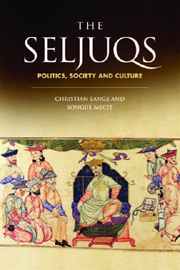Book contents
- Frontmatter
- Contents
- List of figures
- Acknowledgements
- List of abbreviations
- INTRODUCTION
- PART I POLITICS
- PART II SOCIETY
- 6 ARSLĀN ARGHŪN – NOMADIC REVIVAL?
- 7 CONTROLLING AND DEVELOPING BAGHDAD: CALIPHS, SULTANS AND THE BALANCE OF POWER IN THE ABBASID CAPITAL (MID-5TH/11TH TO LATE 6TH/12TH CENTURIES)
- 8 THE SELJUQS AND THE PUBLIC SPHERE IN THE PERIOD OF SUNNI REVIVALISM: THE VIEW FROM BAGHDAD
- 9 CHANGES IN THE OFFICE OF ḤISBA UNDER THE SELJUQS
- 10 AN EMBLEMATIC FAMILY OF SELJUQ IRAN: THE KHUJANDĪS OF ISFAHAN
- Part III CULTURE
- Index
10 - AN EMBLEMATIC FAMILY OF SELJUQ IRAN: THE KHUJANDĪS OF ISFAHAN
from PART II - SOCIETY
Published online by Cambridge University Press: 12 September 2012
- Frontmatter
- Contents
- List of figures
- Acknowledgements
- List of abbreviations
- INTRODUCTION
- PART I POLITICS
- PART II SOCIETY
- 6 ARSLĀN ARGHŪN – NOMADIC REVIVAL?
- 7 CONTROLLING AND DEVELOPING BAGHDAD: CALIPHS, SULTANS AND THE BALANCE OF POWER IN THE ABBASID CAPITAL (MID-5TH/11TH TO LATE 6TH/12TH CENTURIES)
- 8 THE SELJUQS AND THE PUBLIC SPHERE IN THE PERIOD OF SUNNI REVIVALISM: THE VIEW FROM BAGHDAD
- 9 CHANGES IN THE OFFICE OF ḤISBA UNDER THE SELJUQS
- 10 AN EMBLEMATIC FAMILY OF SELJUQ IRAN: THE KHUJANDĪS OF ISFAHAN
- Part III CULTURE
- Index
Summary
The Khujandīs, a family of Shāfiʿī ʿulamāʾ (religious scholars) brought to Isfahan by Niẓām al-Mulk, were major actors in that city during the Seljuq period and up to the Mongol invasion. From the end of the 5th/11th century they headed the local Niẓāmiyya madrasa, and they were also hereditary holders of the city's main local office, the riyāsa. The duration of their influence, the extent of their network and their capacity for political action were arguably unequalled in Seljuq-controlled territory. As the leading family in the greatest city of western – soon of all – Iran, they appear frequently in the sources on the period. However, and this is fairly typical of the lack of research on urban societies in western Iran in the two crucial centuries previous to the Mongol invasion, they have been largely overlooked in Western historiography (in comparison with Khurasan or the Arab Near East). The studies devoted to them to date are incomplete and inaccurate. None take into consideration the documents in the inshāʾ compilation al-Mukhtārāt min al-rasāʾil, which contains forty letters written by or for the Khujandīs, even though the opportunity of combining historiographical sources with documents tantamount to an archive is exceptional and, in the current state of our corpus, unavailable for any other family of pre-Mongol Iran. The main problem, however, is that these studies treat the Khujandīs in isolation from their context, thus depriving themselves of any way to explain either their power or their rise and fall.
- Type
- Chapter
- Information
- The SeljuqsPolitics, Society and Culture, pp. 182 - 202Publisher: Edinburgh University PressPrint publication year: 2011



